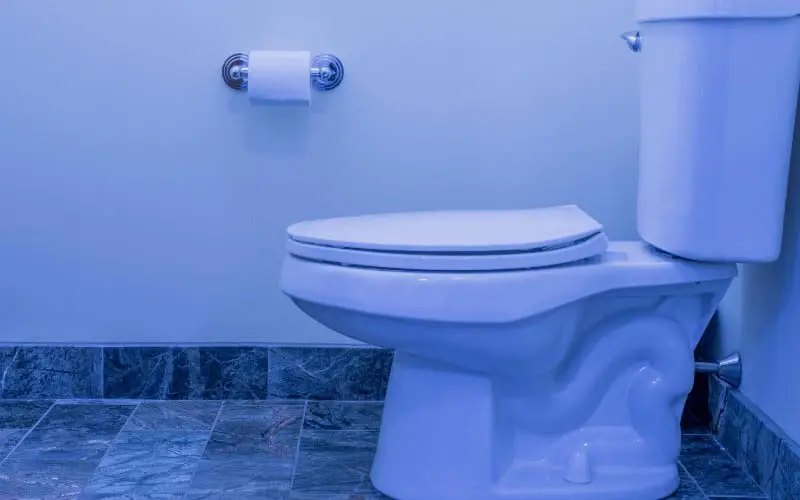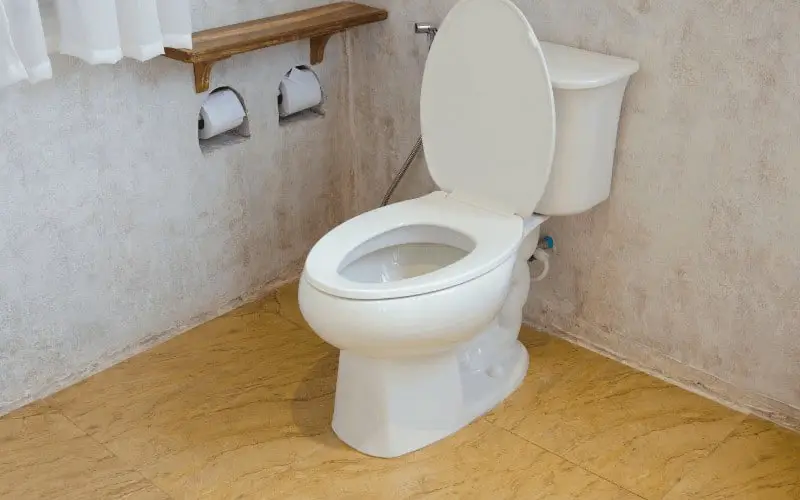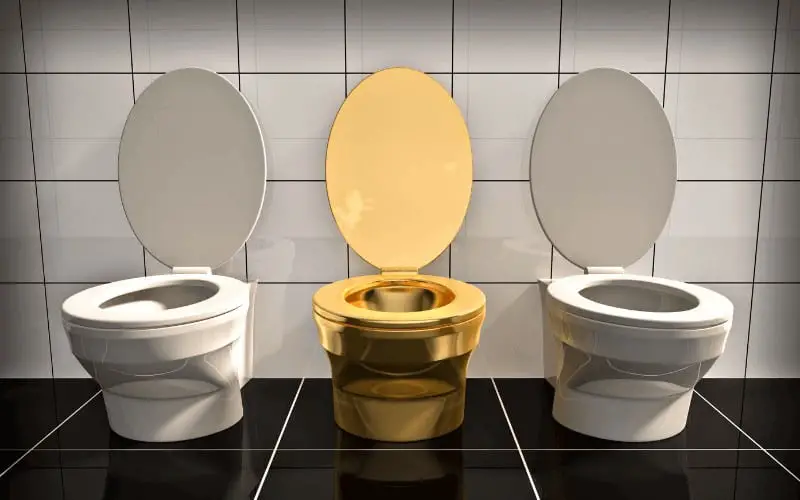Vinyl tiles are a great way to cover a bathroom floor but fitting the tiles around the toilet base can be quite difficult. But although it may seem like a daunting task to install a vinyl tile around a toilet, the process isn’t that complicated and even an inexperienced homeowner can undertake this project.
Installing vinyl tile around a toilet requires a few steps such as cutting the tiles, creating a template or pattern for the cut, smoothening the tile edges and finally laying the tile.
One of the trickiest parts about installing vinyl tile around a toilet is having to create the unique cuts and shapes of a toilet base. Let’s look into more details on how to cut vinyl floor tiles around a toilet.
Read: How easy is it to lay vinyl tile
How to Cut Vinyl Floor Tiles Around a Toilet
Table of Contents
1. Tracing and cutting the tiles
Before trying to cut vinyl floor tiles around a toilet you need to first Install the tiles surrounding the toilet. You need to plan out your tile pattern and also create gridlines on the subfloor so that you only make as few angular/circular tile cuts as possible.
If the toilet has already been installed prior to the tile installation you need to plan out the pattern you will be using in a way that there are at least 2 inches of space between the base of the toilet and the edges of the surrounding tiles.
If your toilet has already been installed it will save you a lot of time, as well as make the cut more precise if you remove the toilet before tiling the floor and replace the toilet afterward.
However, if do not know how to safely uninstall and install a toilet, it would be preferable to let it be and tile around it.
Read: How to clean shower floor
If your installed toilet’s base rests flush against the wall behind the toilet it would be best to tile around it but If you have to tile all the way around the base, including the small space present between it and the wall, then removing the toilet before, tiling around the toilet flange, and then reinstalling the toilet might be the right way to go.
2. Create a Template
To create a template or pattern for the cut you need to make on the tiles you can make use of sheets of paper that are the same size as a whole tile.
If you have a big sheet of paper you can cut it to match the size of the tile. You will need one sheet of paper for each tile you’ll need to install all around the base of the toilet.
You can Estimate your tile cuts and create parallel slits on the paper in these areas. Try to Visualize how each tile will fit around the toilet base, then use that image to estimate which parts of each tile needs to be cut.
Place these estimates on the corresponding sheets of paper, and use a pair of scissors to cut out parallel slits that are about 0.25 inches apart in the areas that will be cut out. When making estimates it is better to overestimate the area that needs to be cut out than to underestimate it.
For example, if you have a toilet with an angular base you will need to remove a triangular section from one of the corners of the tiles.
You will need to cut parallel slits into that same area of the corresponding sheet of paper, you will also need to add a little extra space to your cuts.
Lay each sheet of paper down into places that their corresponding tiles will be and crease the slits along the toilet base, remember to leave enough spacing between tiles for grout lines.
Create a crease into each silt one at a time at the area where the subfloor meets the toilet base using your finger and The creased slits will sit over the installed toilet’s base.
After creating an accurate template for one tile, you can move on to the next following the same process. you can make use of plastic spacers that are used to set tiles in place To account for future grout lines.
After creasing all the sheets of paper you will need to carefully cut the slits along the traced lines, then dry-fit the sheets by laying them around the toilet after accounting for the grout lines and make sure they fit securely against the toilet base.
If you find out that any of your templates do not, you will need to repeat the process.
You need to make sure that all your templates fit precisely around the toilet base because that is how you want your finished tiles to be.
3. Cut Out the Tiles
After getting an accurate template, tape it to the tiles, then use a pencil to trace and scribe the cut lines. use a tile scribe to score 0.125 inches deep lines into the tiles, then trace over the top of the pencil lines.
You can Tile scribes at hardware stores or online and they look like thick pencils or come in various shapes.
Use tile nippers to carefully Remove the unneeded tile. Slowly and carefully squeeze the handles of the nippers to remove small pieces of tile from the areas that need to be removed.
When you reach the scoreline, you have to reduce the size of tile you nibble away, removing a large piece of tile may break your tile which means you have to start over.
If you dont know what Tile nippers are or what they look like, they resemble a giant fingernail clippers and even function like one. Tile nippers are a very important tool that you need for any tile job.
With Standard nippers, you can cut ceramic and porcelain tiles, but if you have glass or fragile stone tiles you may want to use specialty nippers.
Before embarking on the tile cutting process you need to don safety glasses so that shards of tile do not find their way into your eyes, you will also need sturdy work gloves to protect your hands from the sharp edges of tiles.
4. Smoothen the Tile Edges
After cutting the tiles with a tile nipper you will need a tile file to sand down or smoothen any rough edges along the cut. Then use a damp cloth to wipe away any dust that might have been created during the sanding process.
Afterward, try to dry-fit the tile to make sure it rests snugly along the toilet base. If it doesn’t, you will need to keep nipping, or if necessary get a new tile and start again.
After cutting, filling, cleaning, and dry-fitting your tile to make sure it fits the base of your toilet, it is time to set them in place permanently.
5. Install the Tiles
When installing tiles on your bathroom floor you need to start at the areas farthest away from the toilet flange. Simply mark out your desired grid pattern on the floor, then start laying the tiles over unobstructed areas first.
When tiling your bathroom floor, do not tile around the toilet flange which is the circular piece that connects to the drainpipe and what the toilet rests upon until the end.
Start by Drawing out a grid pattern for the tile layout on a sheet of paper, and then on the subfloor itself, this helps to reduce the number of tile cuts you may need to make.
If you are making use of large tiles like 12 by 12 inches or even larger, you may be able to get a complete circle that will go around the flange out of a single tile.
Cut out the number of sheets that match the size of your tiles. That is If one tile can go around the flange completely, cut 1 sheet of paper but if you need 4 tiles to go round the flange, cut 4 sheets of paper. You need to Be as precise as possible when sizing the sheets of paper.
Also, make sure to cut your sheets of paper according to the tile dimensions. next Trace out the outline of the flange onto the sheet(s) of paper but first create a crease in the paper by running your finger along the outline of the flange.
Then, lift up each sheet of paper and begin tracing the outline using a pencil. You need the outline you trace to be about 0.25 inches larger than the creased outline.
Even if your tracing isn’t perfect, do not worry because when the toilet rests on top of the flange and the cut tiles it will hide any minor errors.
If the flange is removable or you want it to rest on top of the tiles instead of on the subfloor, you can make the pencil tracing about 0.5 inches smaller than your crease outline instead. This way, the outer edge of the flange will be placed on top of the surrounding tiles.
Use a pair of scissors to Cut out the flange circle making sure to get the correct shape, then tape it on the tiles and trace it out. Use a pencil to Transfer the cut lines onto the tiles and remove the paper.
Do not throw away the template sheet of paper as you may need it again in the event of a broken tile.
If the toilet flange is going to be removable resting on top of the installed tiles, you need to make you remove it before dry-fitting and also when laying the tile.
If the tiles dry-fit the lines up snugly, it is time to permanently install the tiles to the floor.
Read: How to fix loose tile floors
Installing tiles around your toilet
To get the circular-shaped tile to cover your toilet’s flange you can make use of an angle grinder. Attach a 4 inches diamond wheel blade to the grinder, and place the circular blade at about a 45-degree angle to the tile.
Start working your way slowly around the circle traced into the tile, making sure to use very light pressure. You only need to score the tile about 0.125 inches deep on this initial pass.
Before handling an angle grinder make sure to don protective clothing like safety goggles, gloves, long pants, and sleeves. If you have long hair you need to tie it up and also remove any dangling jewelry.
Due to the amount of dust that will be produced during the process, you may need to wear a dust mask and if you don’t have a vacuum attachment you can consider buying one so that you can connect it to your grinder.
You can get Angle grinders at any hardware store and they are an affordable and useful small power tool. Although Diamond blades can cut through tiles better they are more expensive than other blades.
If there is less than 1.5 inches of space between your traced circle and an edge of the tile, your tile is likely to break while cutting it. In this case, you will need a grinder to cut 2 or more deep score lines that is about halfway through the tile which will run from the perimeter of the circle to the nearest tile edge.
You want the tiles to snap and break at chosen and controlled spots, instead of randomly.
After setting the tile in place, Straight, short, controlled breaks will be barely noticeable especially since the toilet will be resting on top of it.
Using the angle grinder Continue grinding around the circle with gentle pressure and Once you’ve finished scoring the tile surface and creating any sacrificial break notches, continue making passes slowly but steadily with the grinder at a 45-degree angle.
If the tile should break at any of the sacrificial points, simply remove that section and continue cutting. After grinding your way through the tile and you should have the needed circular cutout.
Make sure not to cut more than about 0.125 inches deep with any single pass, or the tile may break in a random spot that will cause you to start over.
You need to Be as precise as you possibly can but remember the circle doesn’t have to be perfect as the cut line will be covered by the toilet base.
Before securing the tile permanently in place make sure to Dry-fit the tile over the flange to make sure it fits. Make sure your circular cutout is not more than 0.5 inches larger than the toilet flange all the way around, the will ensure that the base of the toilet will be able to cover the cutout.
Once you are sure the tile fits properly, you can go ahead and secure it to the floor permanently.
Read: Best way to clean vinyl tile floor
Conclusion
Knowing how to cut vinyl floor tiles around a toilet is very important as it would enable you to install your tiles seamlessly.


